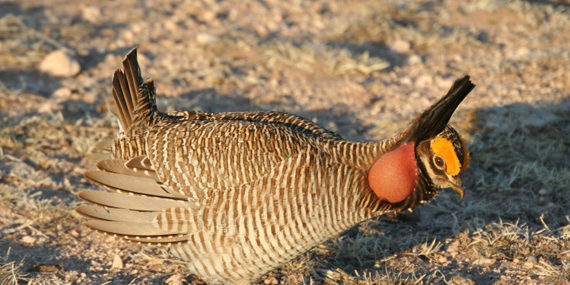Bird of The Week: Lesser Prairie-Chicken
SCIENTIFIC NAME: Tympanuchus pallidicinctus
POPULATION: 32,000
TREND: Decreasing
HABITAT: Short and mixed-grass prairie of the southern Great Plains
The Lesser Prairie-Chicken is slightly smaller than its close relative, the Greater Prairie-Chicken. Like that species, males perform elaborate courtship dances each spring at group display sites known as leks.
The species name, pallidicinctus, derives from the Latin pallidus, meaning pale, and cinctus, meaning banded. The bird’s pale brown plumage is effective camouflage in the sandy sage and oak prairies the bird favors. That habitat is becoming harder to come by, however: Habitat loss and degradation have reduced the Lesser Prairie-Chicken’s range by 92 percent since the 1800s.
Prairie Chicken on a Collision Course
Like the Greater Sage-Grouse, this species tends to avoid power lines and other tall structures, such as wind turbines and cell phone towers, where predators can perch. These obstacles also lead to further habitat fragmentation and reduced breeding success.
Collisions with barbed-wire fences and utility cables cause high mortality in some areas. In addition, ongoing drought and an increasing demand for both fossil fuels and renewable energy development (including wind energy and biofuels) threaten the species’ remaining habitat.
Not?
Our partners at the USDA’s National Resources Conservation Service launched the Lesser Prairie-Chicken Initiative (LPCI) in 2010, establishing a group of government, public, and private groups committed to supporting wildlife conservation through sustainable ranching. This initiative helps ranchers implement conservation measures that benefit prairie chickens, such as removing invasive plants and adopting grazing management systems that provide habitat for the prairie chicken and forage for livestock.
Despite these state-level efforts, the Lesser Prairie-Chicken was listed as federally threatened under the U.S. Endangered Species Act in 2014. However, that decision was recently overturned by a federal court in Texas, which claimed that the U.S. Fish and Wildlife Service failed to make a proper evaluation of the states’ conservation plans.
Opponents of the listing also cited a 25 percent population increase in the species from 2014 to 2015 noted in a recent range-wide aerial survey, likely due to more abundant rains during that period.
At ABC we will be closely watching for impacts of this decision to de-list the species. While there are recent encouraging signs, populations fluctuate significantly over time. Additional impacts from industrial developments could tip the balance since the bird’s recovery is still precarious.
Source: American Bird Conservancy (abcbirds.org)


